
Concept explainers
Provide the IUPAC name for each of the following




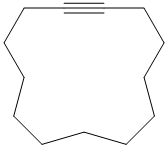
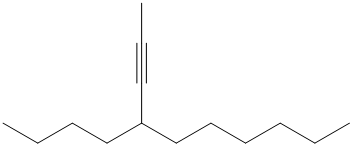

Interpretation:
IUPAC names for the given structures of alkyne are to be written.
Concept introduction:
The presence of a triple bond in a structure represents that the hydrocarbon is an alkyne.
To determine the name of the parent alkyne, select the longest continuous carbon chain containing the carbon‐carbon triple bond.
The parent name of the alkyne comes from the IUPAC name for the alkane having the same number of carbon atoms.
The numbers are assigned to the carbon atoms in the parent chain from the end which gives the lowest number to the substituents.
The name of any substituent atom or group and its location is indicated.
Name of substituent present in the structure is written before the name of the parent chain.
Answer to Problem 16P
Solution:
a)
b)
c)
d)
e)
f)
g)
Explanation of Solution
a) The structure is:


The given structure contains a triple bond. There are
b) The structure is:


The given structure contains a triple bond. There are
Hence the name for the given structure is
c) The structure is:

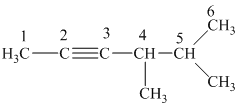
The longest chain in the given structure containing the triple bonded carbon atoms consists of
d) The structure is:

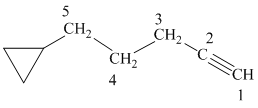
The longest chain in the given structure containing the triple bonded carbon atoms consists of
e) The structure is:
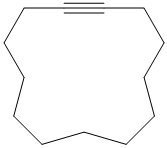
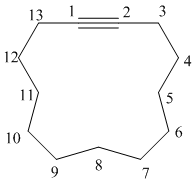
The longest chain in the given structure containing the triple bonded carbon atoms consists of
f) The structure is:
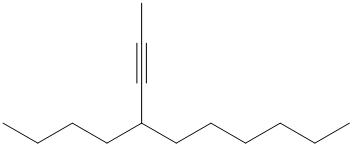
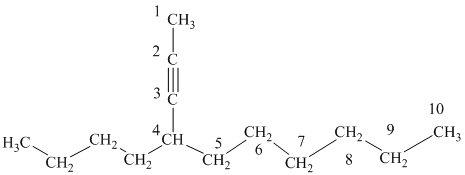
The longest chain in the given structure containing the triple bonded carbon atoms consists of
g) The structure is:

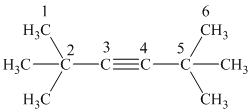
The longest chain in the given structure containing the triple bonded carbon atoms consists of
Want to see more full solutions like this?
Chapter 9 Solutions
ORGANIC CHEMISTRY-W/STUD.SOLN.MAN.
- One liter of chlorine gas at 1 atm and 298 K reacts completely with 1.00 L of nitrogen gas and 2.00 L of oxygen gas at the same temperature and pressure. A single gaseous product is formed, which fills a 2.00 L flask at 1.00 atm and 298 K. Use this information to determine the following characteristics of the product:(a) its empirical formula;(b) its molecular formula;(c) the most favorable Lewis formula based on formal charge arguments (the central atom is N);(d) the shape of the molecule.arrow_forwardHow does the square root mean square velocity of gas molecules vary with temperature? Illustrate this relationship by plotting the square root mean square velocity of N2 molecules as a function of temperature from T=100 K to T=300 K.arrow_forwardDraw product B, indicating what type of reaction occurs. F3C CF3 NH2 Me O .N. + B OMearrow_forward
- Benzimidazole E. State its formula. sState the differences in the formula with other benzimidazoles.arrow_forwardDraw product A, indicating what type of reaction occurs. F3C CN CF3 K2CO3, DMSO, H₂O2 Aarrow_forward19) Which metal is most commonly used in galvanization to protect steel structures from oxidation? Lead a. b. Tin C. Nickel d. Zinc 20) The following molecule is an example of a: R₁ R2- -N-R3 a. Secondary amine b. Secondary amide c. Tertiary amine d. Tertiary amidearrow_forward
- pls helparrow_forwardpls helparrow_forward35) Complete the following equation by drawing the line the structure of the products that are formed. Please note that in some cases more than one product is possible. You must draw all possible products to recive full marks! a. ethanol + 2-propanol + H2SO4 → b. OH conc. H2SO4 CH2 H3C CH + K2Cr2O7 C. d. H3C A pressure CH3 + H2 CH Pt catalystarrow_forward

 Organic And Biological ChemistryChemistryISBN:9781305081079Author:STOKER, H. Stephen (howard Stephen)Publisher:Cengage Learning,
Organic And Biological ChemistryChemistryISBN:9781305081079Author:STOKER, H. Stephen (howard Stephen)Publisher:Cengage Learning, General, Organic, and Biological ChemistryChemistryISBN:9781285853918Author:H. Stephen StokerPublisher:Cengage Learning
General, Organic, and Biological ChemistryChemistryISBN:9781285853918Author:H. Stephen StokerPublisher:Cengage Learning


